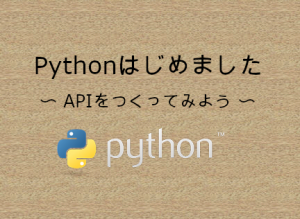【Python】Flask + MySQL + SQLAlchemyでAPIを開発してみよう Part2
2019.09.09

こんにちは、せんだです。
ようやく夏の厳しい暑さが落ちついてきたかな?と思う今日この頃。
と見せかけてまだまだ涼しいとは程遠い(主観です)ので、皆さま体調管理にはお気をつけ下さいませ。
さて、前回に引き続きPythonの軽量フレームワーク「Flask」を使ったAPIの作り方について書きます。
前回の記事はこちら
【Python】Flask + MySQL + SQLAlchemyでAPIを開発してみよう Part1
前回はFlaskのインストール、ルーティング、レスポンスの雛形をとりあえず作りました。
今回やることはこちら。
今回やること
- モジュールのインストール
- DB連携の設定
- モデルの作成
- 取得したデータをJSON形式で返す
環境
端末:Mac Book Pro
Pythonバージョン: 3.6.8
Flaskバージョン: 1.0.3
MySQLバージョン: 5.7
SQLAlchemy バージョン:1.3.4
ディレクトリ構成
ディレクトリ構成はこんな感じです。
1 2 3 4 5 6 7 8 9 10 11 12 13 14 15 | app.py ... 起動ファイル | config.py ... 設定ファイル | api ├── __init__.py ... FlaskApp本体 │ ├── database.py ... DB情報 │ ├── models ... Model群 │ └── users.py │ └── __init__.py │ └── views ... Controller群 └── user.py |
モジュールのインストール
今回使うモジュールをインストールします。
1 | $ pip install SQLAlchemy, Flask-SQLAlchemy, Flask-Cors, marshmallow, marshmallow-sqlalchemy, flask-marshmallow |
DB連携の設定
DB接続に必要なコードを書いていきます。
conifg.py
1 2 3 4 5 6 7 8 9 10 11 12 | class SystemConfig: DEBUG = True SQLALCHEMY_DATABASE_URI = 'mysql+pymysql://{user}:{password}@{host}/{db_name}?charset=utf8'.format(**{ 'user': '<接続ユーザー>', 'password': '<接続パスワード>', 'host': '<接続先ホスト>', 'db_name': '<接続先データベース名>' }) Config = SystemConfig |
あくまで必要最低限ですが、DBの接続情報を記述しています。
最後の
1 | Config = SystemConfig |
という記述でConfigという名前で外部ファイルから読み込める様にしています。
api/database.py
1 2 3 4 5 6 7 8 9 | from flask_sqlalchemy import SQLAlchemy from flask_marshmallow import Marshmallow db = SQLAlchemy() ma = Marshmallow() # アプリでDB操作を行えるように初期設定する def init_db(app): db.init_app(app) |
FlaskアプリからSQLAlchemyとMarshmallowを使う為の定義をしています。
api/__init__.py
1 2 3 4 5 6 7 8 9 10 11 12 13 14 15 16 17 18 19 20 21 22 | from flask import Flask, make_response, jsonify from .views.user import user_router from flask_cors import CORS from api.database import db import config def create_app(): app = Flask(__name__) # CORS対応 CORS(app) # DB設定を読み込む app.config.from_object('config.Config') db.init_app(app) app.register_blueprint(user_router, url_prefix='/api') return app app = create_app() |
先ほど設定したconfig.py、database.pyを読み込み、Flaskアプリを起動します。
とりあえず、これでSQLAlchemyを使ったDB連携の下準備が整いました。
モデルの作成
次はモデルを書いて、SQLAlChemyを使って、データの操作を行います。
api/models/user.py
1 2 3 4 5 6 7 8 9 10 11 12 13 14 15 16 17 18 19 20 21 22 23 24 25 26 27 28 29 30 31 32 33 34 35 36 37 38 39 40 41 42 | from api.database import db, ma class User(db.Model): __tablename__ = 'users' id = db.Column(db.Integer, primary_key=True, autoincrement=True) name = db.Column(db.String(50), nullable=False) address= db.Column(db.String(100), nullable=True) tel = db.Column(db.String(20), nullable=True) mail = db.Column(db.String(100), nullable=True) def __repr__(self): return '<User %r>' % self.name def getUserList(): # select * from users user_list = db.session.query(User).all() if user_list == None: return [] else: return user_list def registUser(user): record = User( name = user['name'], address = user['address'], tel = user['tel'], mail = user['mail'] ) # insert into users(name, address, tel, mail) values(...) db.session.add(record) db.session.commit() return user class UserSchema(ma.ModelSchema): class Meta: model = User fields = ('id', 'name', 'address', 'tel', 'mail') |
こんな感じにDBの構造を定義します。
下の方に書いたのは、ユーザー一覧取得用のメソッドと登録用のメソッドです。
1 2 3 4 | class UserSchema(ma.ModelSchema): class Meta: model = User fields = ('id', 'name', 'address', 'tel', 'mail') |
取得したデータをJSON形式で返す
最後にモデルを使って、DB操作を行いJSON形式でレスポンスします。
api/views/user.py
1 2 3 4 5 6 7 8 9 10 11 12 13 14 15 16 17 18 19 20 21 22 23 24 25 26 27 28 29 30 31 32 | from flask import Blueprint, request, make_response, jsonify from api.models import User, UserSchema import json # ルーティング設定 user_router = Blueprint('user_router', __name__) @user_router.route('/users', methods=['GET']) def getUserList(): users = User.getUserList() user_schema = UserSchema(many=True) return make_response(jsonify({ 'code': 200, 'users': user_schema.dump(users).data })) @user_router.route('/users', methods=['POST']) def registUser(): # jsonデータを取得する jsonData = json.dumps(request.json) userData = json.loads(jsonData) user = User.registUser(userData) user_schema = UserSchema(many=True) return make_response(jsonify({ 'code': 200, 'user': user })) |
先ほど、準備したモデルを使ってコントローラーを記述します。
上記のようにModelを読み込む際は api/models/__init__.pyに下記を追記します。
api/models/__init__.py
1 | from .user import User, UserSchema |
確認
api/usersにPOST、GETでアクセスするとそれぞれステータス200が返ってくるかと思います。
[GET] api/users
1 2 3 4 5 6 7 8 9 10 11 12 13 14 15 16 17 18 19 20 21 | # レスポンス { "code": 200, "users": [ { "address": "茨城県つくば市千現", "id": 1, "mail": "ichirou@swallow-incubate.com", "name": "鈴木一郎", "tel": "0281234567" }, { "address": "茨城県つくば市千現", "id": 2, "mail": "jirou@swallow-incubate.com", "name": "佐藤二郎", "tel": "0281234567" } ] } |
[POST] api/users
1 2 3 4 5 6 7 8 9 10 11 12 13 14 15 16 17 18 19 20 21 | # リクエストbody { "name": "山田太郎", "address":"茨城県つくば市千現", "tel":"02812345678", "mail":"blogtest@swallow-incubate.com" } # レスポンス { "code": 200, "user": { "address": "茨城県つくば市千現", "mail": "blogtest@swallow-incubate.com", "name": "山田太郎", "tel": "0281234567" } } |
まとめ
今回はFlaskとSQLAlchemyを使って実際にMySQLとの連携部分を実装しました。
ここまでで、とりあえずFlask + MySQL + SQLAlchemyでWeb APIを作る事ができたと思います。
それでは、また次回!
Flask + MySQL + SQLAlchemyシリーズ
↓↓↓ぜひチェックしてください
~提供中のヒューマンセンシング技術~
◆人物検出技術
歩行者・来店者数計測やロボット搭載も
https://humandetect.pas-ta.io
◆視線検出技術
アイトラッキングや次世代UIに
https://eyetrack.pas-ta.io
◆生体判定技術
eKYC・顔認証のなりすまし対策を!
https://bio-check.pas-ta.io
◆目検出技術
あらゆる目周りデータを高精度に取得
https://pupil.pas-ta.io
◆音声感情認識技術
会話から怒りや喜びの感情を判定
https://feeling.pas-ta.io
◆虹彩認証技術
目の虹彩を利用した生体認証技術
https://iris.pas-ta.io















